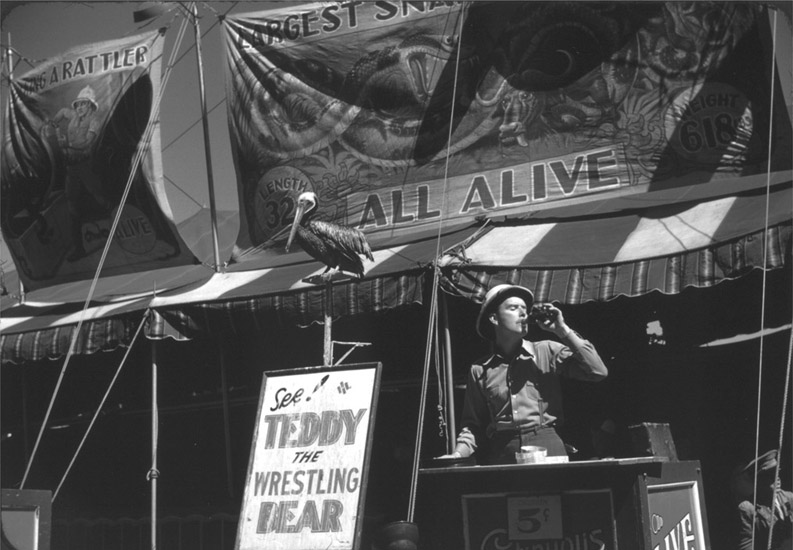
Festivals have brought together peoples for trade and entertainment since ancient times. In more recent times, such festivals—like this 1941 Vermont carnival—have lost much of their trading dimension. (Library of Congress)
Open-air markets held by traveling merchants during the Medieval period.
In the twelfth century, merchants traveled with their goods to different villages, where for a few days or even a few weeks a year an open-air market would be held. At this time, permanent markets were nonexistent, so this was the primary exhibition of goods and services. Buyers and sellers would gather to transact business. Although a fair could be the product of religious, secular, and economic activities, the primary function remained the promotion of trade. Many fairs originated in religious events that required many people for extended periods of time. Among ancient Greek and Roman times, fairs or public markets were used to announce new public laws. In early Christian times, religious events were used as special occasions for marketing. During the thirteenth century, every German town held at least one annual cattle and horse market or fair where local traders competed with one another. The most prosperous one—which survives as a successful trading event today—was held in Hochheim am Main, near Frankfurt, beginning in 1483.
Many of the villages near major rivers hosted fairs. For example, the various towns of Champagne, lying where the Saône, Rhone, and Seine Rivers meet, held various fairs year round. Before people were able to travel easily, fairs furnished the primary opportunity for the exchange of goods and served as a community social activity. They also brought people together from different villages, and thus were places where one might find a marriage partner. Fairs are ancient and universal mechanisms for regional and even international interaction. Fairs were held generally at the same location and time of year and would last between a few days and a few weeks. During the sixteenth century, fairs occurred on an annual or semiannual basis. These fairs were commonly a gathering of local producers, both agricultural and artisan, petty merchants, and local consumers. In pursuing economic goals, the merchants also reflected their own backgrounds and interests throughout such gatherings. In the seventeenth century, pleasure fairs emerged. These fairs were dominated by entertainments such as plays and became popular.
One of the first known successful fairs began in Britain around 1125. It was known as the Boston Fair and was the most popular in Europe. Commercial life revolved around this fair, which was a privilege granted to the town by the Crown. There were exhibitions by monks, natives, and foreigners. The main commodities from England at this time included wool, iron, and lead, which were exchanged for furs and falcons from Norway, wine from France and Italy, cloth from the Low Countries, and spices and other exotic items from the eastern Mediterranean. The king’s servants were allowed to purchase goods at this fair.

Festivals have brought together peoples for trade and entertainment since ancient times. In more recent times, such festivals—like this 1941 Vermont carnival—have lost much of their trading dimension. (Library of Congress)
Many new trade routes were developed because of such fairs. Producers, traders, and consumers traveled from long distances to take part in these exhibitions. The major trade routes that developed throughout this time directly affected the growth of individual trade fairs; among the most prominent were Geneva, Madrid, Antwerp, Burgundy, and Bartholomew Fair in England. Of the variety of goods traded at such fairs, cloth was probably the most important. An alliance was also created between 1250 and 1450 that united northern Europe as one economic unit. This consisted of many port cities joined together for a more effective way to travel. The alliance, known as the Hanseatic League (“hansa” means guild or company), ensured the security of the merchants and the goods being transported. This league devel oped a more organized and secure method for traveling to and from the long-distance ventures. The Hanseatic League had its own flag, developed its own laws, and engaged in diplomacy with foreign governments.
Fairs have always been one of people’s most enjoyable experiences, a universal part of cultural life around the world. In Eltville, Germany, the locals have celebrated the Festival of Sparkling Wine since 1811, which focuses on their most precious local product. This not only boosts the local economy, but creates an artificial demand for the product. No fewer than 200,000 join the community for the celebration every June. Another enduring example is the Hochheim Market, which began as a cattle and horse trading fair in the fifteenth century and now attracts some 300,000 visitors every November with its arts and crafts displays, livestock shows, auctions, food and wine stands, and other features.
Fairs have adapted to many changes throughout the centuries, including changes in consumer demand for what is bought and sold. However, three major factors concerning the success of fairs have not changed: concept, location, and date. To this day, fairs continue to display many different kinds of products in specific commodity or industrial groupings. The fairs also support the local economies.
Danielle Poole
See also: Fairs, International Trade.
Augur, Helen. The Book of Fairs. Detroit: Omnigraphics, 1992.
Walford, Cornelius. Fairs, Past and Present: A Chapter in the History of Commerce. New York: Augustus M. Kelley, 1968.